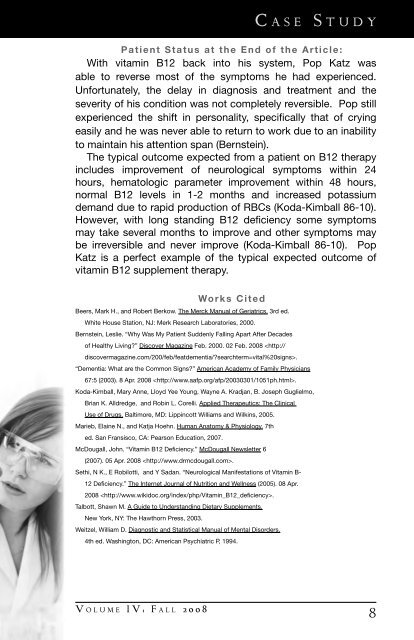2008 - Communication Across the Curriculum (CAC)
2008 - Communication Across the Curriculum (CAC)
2008 - Communication Across the Curriculum (CAC)
Create successful ePaper yourself
Turn your PDF publications into a flip-book with our unique Google optimized e-Paper software.
C a s e S t u d y<br />
Patient Status at <strong>the</strong> End of <strong>the</strong> Article:<br />
With vitamin B12 back into his system, Pop Katz was<br />
able to reverse most of <strong>the</strong> symptoms he had experienced.<br />
Unfortunately, <strong>the</strong> delay in diagnosis and treatment and <strong>the</strong><br />
severity of his condition was not completely reversible. Pop still<br />
experienced <strong>the</strong> shift in personality, specifically that of crying<br />
easily and he was never able to return to work due to an inability<br />
to maintain his attention span (Bernstein).<br />
The typical outcome expected from a patient on B12 <strong>the</strong>rapy<br />
includes improvement of neurological symptoms within 24<br />
hours, hematologic parameter improvement within 48 hours,<br />
normal B12 levels in 1-2 months and increased potassium<br />
demand due to rapid production of RBCs (Koda-Kimball 86-10).<br />
However, with long standing B12 deficiency some symptoms<br />
may take several months to improve and o<strong>the</strong>r symptoms may<br />
be irreversible and never improve (Koda-Kimball 86-10). Pop<br />
Katz is a perfect example of <strong>the</strong> typical expected outcome of<br />
vitamin B12 supplement <strong>the</strong>rapy.<br />
Works Cited<br />
Beers, Mark H., and Robert Berkow. The Merck Manual of Geriatrics. 3rd ed.<br />
White House Station, NJ: Merk Research Laboratories, 2000.<br />
Bernstein, Leslie. “Why Was My Patient Suddenly Falling Apart After Decades<br />
of Healthy Living” Discover Magazine Feb. 2000. 02 Feb. <strong>2008</strong> .<br />
“Dementia: What are <strong>the</strong> Common Signs” American Academy of Family Physicians<br />
67:5 (2003). 8 Apr. <strong>2008</strong> .<br />
Koda-Kimball, Mary Anne, Lloyd Yee Young, Wayne A. Kradjan, B. Joseph Guglielmo,<br />
Brian K. Alldredge, and Robin L. Corelli. Applied Therapeutics: The Clinical<br />
Use of Drugs. Baltimore, MD: Lippincott Williams and Wilkins, 2005.<br />
Marieb, Elaine N., and Katja Hoehn. Human Anatomy & Physiology. 7th<br />
ed. San Fransisco, CA: Pearson Education, 2007.<br />
McDougall, John. “Vitamin B12 Deficiency.” McDougall Newsletter 6<br />
(2007). 05 Apr. <strong>2008</strong> .<br />
Sethi, N K., E Robilotti, and Y Sadan. “Neurological Manifestations of Vitamin B-<br />
12 Deficiency.” The Internet Journal of Nutrition and Wellness (2005). 08 Apr.<br />
<strong>2008</strong> .<br />
Talbott, Shawn M. A Guide to Understanding Dietary Supplements.<br />
New York, NY: The Hawthorn Press, 2003.<br />
Weitzel, William D. Diagnostic and Statistical Manual of Mental Disorders.<br />
4th ed. Washington, DC: American Psychiatric P, 1994.<br />
V o l u m e I V : F a l l 2 0 0 8<br />
8






